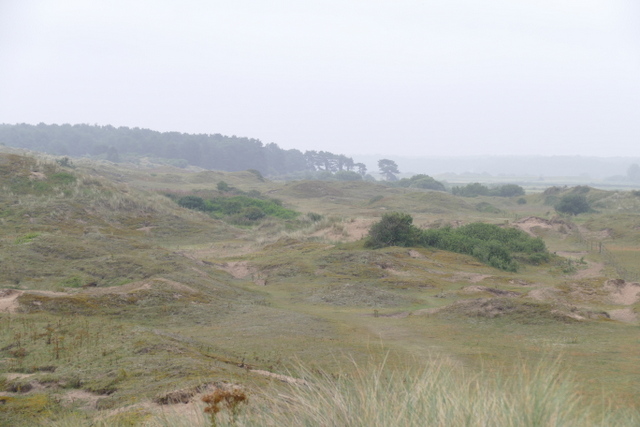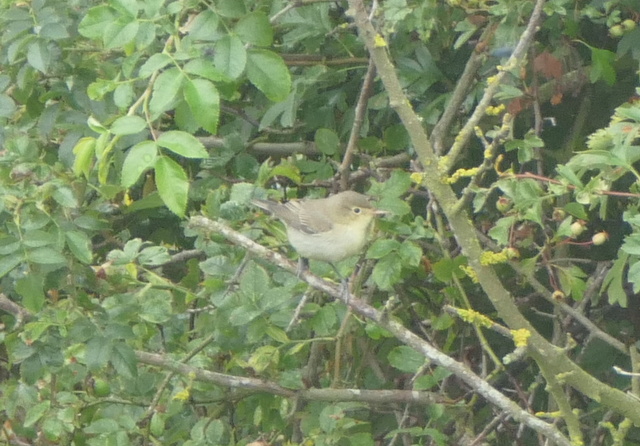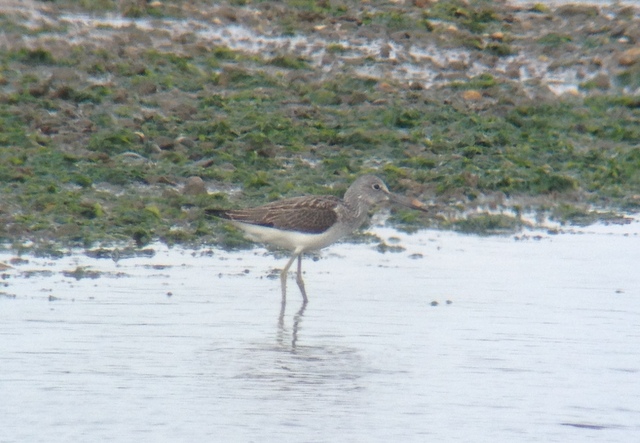Day 1 of a long weekend of tours today. With easterly winds and a little flurry of migrants arriving on the coast late the night before, we headed for Holkham & Burnham Overy Dunes.
We parked at Lady Ann’s Drive and walked west on the inland side of the pines. There were various warblers calling from the trees. We came across a family party of Chiffchaffs, the young still begging for food, and we heard several Blackcaps tacking loudly. As we walked along, a couple of tit flocks crossed the path ahead of us. We stopped to look through them – a good selection of tits, plus Goldcrests, Treecreepers, more Blackcaps and Chiffchaffs. We couldn’t find anything more unusual amongst them.
Most of our Swifts have left us already, but when we looked up at a big group of House Martins hawking for insects low over the pines, we found one or two Swifts still amongst them. A lone Little Grebe was on Salts Hole as we passed.
Past Meals House, we stopped to scan the grazing marshes. A juvenile Marsh Harrier, dark chocolate brown with contrasting orangey-yellow crown, was jumping about in the grass. A lone goose nearby was clearly not one of the resident feral Greylag Geese – its smaller size, dark head and small mostly dark bill suggested something more interesting. Getting it in the scope, we could confirm it was a lone Pink-footed Goose. We are still a month away from the first geese returning for the winter and we could see that this bird appeared to have a damaged wing. A very small number of mostly sick or injured Pink-footed Geese do remain here for the summer, rather than attempt the long flight up to Iceland to breed.
 Burnham Overy Dunes – on a misty morning
Burnham Overy Dunes – on a misty morning
We headed out of the pines and into the dunes. The bushes seemed surprisingly quiet at first – just a couple of Lesser Whitethroats, calling but typically skulking. It was cool and damp in the misty conditions, so perhaps the birds were just keeping under cover? We did flush a couple of coveys of partridges – the first being Red-legged Partridges and the second being the native Grey Partridges which can often be found in the dunes.
As we drove out to Holkham in the morning, news had come through about an Icterine Warbler at the Burnham Overy end of the dunes. With the apparent lack of migrants at the Holkham end, we made our way west. We could see a couple of people standing on the boardwalk as we approached and we made our way round via the dunes so as not to disturb whatever they were watching. It was the Icterine Warbler, clambering around in the bushes, and flicking between them. It was quite showy at first and we got great views of it – its grey-green upperparts and pale lemon-yellow face, blue-grey legs and pale wing panel.
 Icterine Warbler – showed well in the bushes by the boardwalk
Icterine Warbler – showed well in the bushes by the boardwalk
When it started to drizzle very lightly, the Icterine Warbler got a little more elusive. We climbed up into the dunes and could see it flitting around in the privet. While we were watching it, a bird flew in over the dunes and dropped down into the bushes the other side of the boardwalk. A Pied Flycatcher, presumably fresh in. We walked over and suddenly it flew up into a hawthorn in front of us. Classic autumn drift migrants. With confirmation that there were seemingly no other migrants out further west, we decided to head back and have another look in the dunes.
We had heard Green Sandpipers calling as we walked out. Then, while we were standing by the boardwalk, six Green Sandpipers flew up from the grazing marsh and circled round in front of us before dropping back down out of view. A little later, we heard Greenshanks calling out across the grazing marshes and a quick scan revealed a flock of nine flying west. Waders are on the move.
As we walked back through the dunes, we caught a flash of white rump as a Wheatear shot past. It landed behind us amongst some dead flower heads on a small ridge on the dunes, where it tried to lurk unseen. Eventually it became a little more obliging and hopped back out onto the path.
 Wheatear – hiding in the dunes
Wheatear – hiding in the dunes
There were a couple of juvenile Kestrels on the fence posts by the dunes, looking very pristine with their bright new feathers. A pair bred locally this year. When we looked up at a falcon in the air just above the west end of Holkham Pines we expected it to be another member of the family. It was a Hobby. Two more then appeared with it, the birds were clearly hawking for something – either insects of possibly hirundines over the trees.
Almost back to the west end of the pines, we bumped into another couple of birders scanning over the bushes beyond the fence, just where we had been looking earlier in the morning. The weather had brightened up a bit by this stage and two Redstarts and another Pied Flycatcher had appeared. The others confirmed the birds had come out just as the weather improved. We stood and watched them for a while. While we were doing so, a shape appeared, flying in from the grazing marshes towards the dunes. the distinctive shape, the stiff wings with an odd rowing action in flight, confirmed it was a Short-eared Owl. It flew across and dropped into the dunes out of sight.
After a quiet start, we had ended up seeing quite a haul of migrants during the morning. As time was getting on by this stage, we decided to head back. We came across a couple more mixed flocks of tits and warblers on the way back. Again, we stopped to look through them just in case. A Garden Warbler was the only new bird for the day, following behind one of the groups. A couple of Bullfinch called from the bushes but remained unseen.
 Ruddy Darter – basking on a stone on the path
Ruddy Darter – basking on a stone on the path
The insects were more amenable. With the weather having brightened and warmed, there were lots of dragonflies along the path. Most of them were darters – both Common Darter and Ruddy Darter in good numbers – but Migrant Hawker was also a new one for the day. There were also several butterflies – a Painted Lady in the edge of the dunes, several Holly Blues and a few Red Admirals feeding on the Hemp Agrimony flowers by the path.
 Red Admiral – feeding on Hemp Agrimony
Red Admiral – feeding on Hemp Agrimony
In the afternoon, we headed over to Stiffkey Fen. As we walked down along the path by the road, another Hobby appeared over the trees in front of us, circling overhead before disappearing beyond the hedge. Down in the valley below, a female Marsh Harrier was quartering.
Even as we walked out along the path beside the river, we could see a gathering of large white blobs through the overgrown reeds. When we got to a gap, we confirmed they were indeed the Spoonbills. From up on the seawall, we could see that there were still 20 of them, and they were almost all asleep as usual!
 Spoonbill – still 20 on the Fen today
Spoonbill – still 20 on the Fen today
A couple of them were awake, and we could see they had the shorter, fleshy-coloured bills of juveniles, lacking the adults yellow tip.
 Spoonbills – several juveniles were in amongst the flock
Spoonbills – several juveniles were in amongst the flock
As we got up on the seawall, we could hear Common Sandpiper calling. One flew up the tidal creek and disappeared out of sight. We looked back towards the Fen, and a short while later we could hear them again, and this time we turned to see four Common Sandpipers flying past. Meanwhile, a scan of the Fen had revealed at least three more Common Sandpipers out there, meaning a minimum of seven in total.
A Common Snipe flew over as well, in from the direction of the saltmarsh and dropped into the Fen. We could see its long, straight bill as it came overhead. It tucked itself down in the lee of one of the islands at first, where it was hard to see, before climbing up onto the top to preen. Down at the front, behind the reeds, we picked up a single Little Ringed Plover on one of the other islands.
The largest number of waders out on the Fen were Black-tailed Godwits. Many of the ones already there were sleeping but, while we stood on the seawall, a steady stream of more of them flew in from the direction of the harbour, dropping down to bathe and preen. In amongst them, we found a small number of Ruff, already in pale winter plumage, and a greyer Redshank or two as well.
There was a good variety of wildfowl too, though the ducks are all in eclipse plumage at the moment. A little party of four Wigeon were the most interesting, but there were also Gadwall, Teal and Shoveler, as well as a few Tufted Ducks.
After scanning the Fen, we decided to walk round to have a look at the harbour. The tide was out, so it was one vast expanse of mud this afternoon. The first thing we saw were several large flocks of Oystercatcher on the highest ground, with smaller numbers of Redshank amongst them. A couple of grey-brown Curlew were rather different from the smaller, darker, shorter-billed Whimbrel nearby, a good comparison. While we were scanning the mud, a couple of Greenshank dropped into the tidal channel in front of us.
 Greenshank – one of two in the tidal channel
Greenshank – one of two in the tidal channel
Further over, half hidden behind one of the sandbars, were the distinctive black bellies of several Grey Plover. However, it was only when they were flushed and landed again out in the open that we could see how many there were. At least 90, and most of them still in summer plumage with black bellied and black faces. In amongst them, several smaller waders were lurking – Knot, again a mixture of bright orange-bellied summer plumage birds and greyer winter ones. A little group of Bar-tailed Godwits and a couple of Turnstone as well, added to the wide variety of waders for the day’s list.
There was a good selection of gulls, too. Though nothing out of the ordinary, it was good to compare Lesser Black-backed and Great Black-backed Gulls side by side. A single Great Crested Grebe was swimming out in the pit.
 Small Copper – looking a little old and faded now
Small Copper – looking a little old and faded now
Then it was time to start heading back. The sun had come out and it was even quite warm, so there were plenty of butterflies along the hedgerow as we made our way, though many of them were looking quite old and faded now. Meadow Browns, Speckled Woods, a Ringlet and a Small Copper, plus Small Tortoiseshells and a Peacock.
It had been quite a day in the end – a great selection of Autumn drift migrants in the morning, plus Spoonbills and a good variety of passage waders in the afternoon.
 Stiffkey Fen – the view across Blakeney Harbour to the Point
Stiffkey Fen – the view across Blakeney Harbour to the Point
















